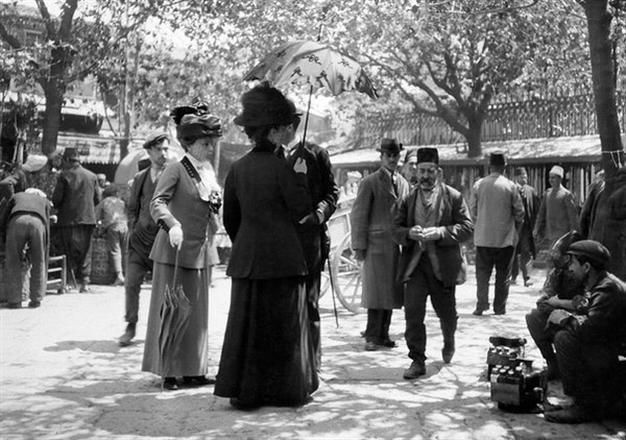An English Kemalist in Anatolia, 1922
William Armstrong - william.armstrong@hdn.com.tr
 ‘An Englishwoman in Angora’ by Grace Ellison (Cambridge University Press, 344 pages, $38)
‘An Englishwoman in Angora’ by Grace Ellison (Cambridge University Press, 344 pages, $38) The name Grace Ellison has almost entirely fallen from the historical record. A journalist by profession, Ellison published a series of books on Ottoman and Turkish society that are today little more than historical curios. But as the world commemorates the 100th anniversary of the First World War, Cambridge University Press has decided to reissue her account of a journey from İzmir to Ankara in the aftermath of the conflict, in the midst of Turkey’s War of Independence. Terribly dated, and full of exuberant Turkophilia that borders on propaganda, the book’s shortcomings are precisely what make it a fascinating relic.
The name Grace Ellison has almost entirely fallen from the historical record. A journalist by profession, Ellison published a series of books on Ottoman and Turkish society that are today little more than historical curios. But as the world commemorates the 100th anniversary of the First World War, Cambridge University Press has decided to reissue her account of a journey from İzmir to Ankara in the aftermath of the conflict, in the midst of Turkey’s War of Independence. Terribly dated, and full of exuberant Turkophilia that borders on propaganda, the book’s shortcomings are precisely what make it a fascinating relic.To describe Ellison as intrepid really wouldn’t be doing her justice - it was more than a little perilous to be an Englishwoman in Anatolia when she made her trip in 1922. After defeating the Ottoman Empire in the war, occupying Constantinople, and supporting the Hellenic invasion of Anatolia, the British were persona non grata in Turkey. Hardly anyone Ellison meets can believe that she is making the journey solo, and many advise her to pretend she is American for her own safety. “God forbid,” she responds in horror, even insisting on carrying a Union Flag around with her out of loyalty to the British Empire. The obvious contradiction between the patriot and the ardent Turkophile continues throughout the book, and Ellison spends pages wringing her hands about Britain’s “terrible and tragic bungling,” bemoaning how its policy toward Turkey has gone “woefully and willfully astray.” As she tells the governor in İzmir at one point, atoning for British misdeeds is part of the motivation behind her trip: “the Turks shall see that one Englishwoman can stand out against injustice … God willing, may I, as one Englishwoman and a friend, preserve for my country some last shred of respect and faith in our honour among the Moslems of Turkey and India, Egypt, Persia, and Palestine.”
Along with self-flagellation comes wild praise for the resistance forces in Anatolia. Despite the utter desolation of post-war Anatolia, everywhere there is “the marvelous atmosphere of a Great Birth.” Midway through her journey, in the amusingly baroque language of the time, she describes “a voice that seems to cut through the chill air”: “Here, where the civilisations of the world’s childhood have flourished; here, on the ruins of the great Empire of the Ancients; here beginneth a new Turkey, the democrat of democracies.” Anti-Greek prejudice naturally accompanies Ellison’s pro-Turkish sympathies, and traveling through Anatolia gives her plenty of opportunity to witness first-hand the destruction of every corner of the country in the aftermath of the Greek retreat. “Greek atrocities,” she writes, have left the land in a pitiful state, “bled white through twelve years of war … On every side lie smashed engines, burnt railway carriages, and villages in cinders … The corn, so carefully hidden in pits, has been burned; the water, on which life itself depends, has been polluted.” Amid the “oppression of desolation,” Ellison’s admiration can only increase for the “resolute Turk.”
On arrival in the “bare and rough Asiatic fortress” of Ankara, Ellison is gripped even more fiercely by Turkish nationalist fervor. She arrives as preparations are being made for the Lausanne peace conference, but the threat of war breaking out again still lurks on the horizon. She meets many of the resistance figureheads, including Mustafa Kemal himself, and has not a bad word to say about any of them. The future Atatürk is “the greatest man in Turkey today” who has “accomplished miracles”; Halide Edib is said to be revered by the Turks “as their Joan of Arc.” Ellison’s admiration is absolute: “Here in Angora, I see them coming along their one wide road. All mingled without a thought of social distinctions; all intent upon the same goal - their country’s freedom; all alike proud of the price they have paid - officers and deputies, ministers and civil servants, soldiers, peasants, and caravan drivers. Are not these, then, the one true democracy of the world?”
Similarly, we witness her adopting much of the puritanical “nativism” of the nationalists in Ankara. On her return to Istanbul at the end of the book, she is revolted by the cosmopolitanism of the Pera district: “What a terrible warning one can take from Pera! I had not realized the danger of losing oneself in the ambition to be truly cosmopolitan. These people belong to all nations and have the souls of none … In Anatolia, I found two forms of inborn honour: the ‘nationalist’ and the ‘primitive peasant.’
In Pera I stepped from Tokatlian’s Hotel to the Embassy with the feeling that someone is going to stab me in the back.”
The book ends with an account of the Conference of Lausanne in 1922-23, where a final treaty was struck between the Turks and the international powers. The “Great Birth” that Ellison witnessed in Anatolia had achieved its ends. Perhaps her inveterate Turkophilia, swimming against the tide of international opinion at the time, had played a small part in helping the Turks secure an honorable peace.










